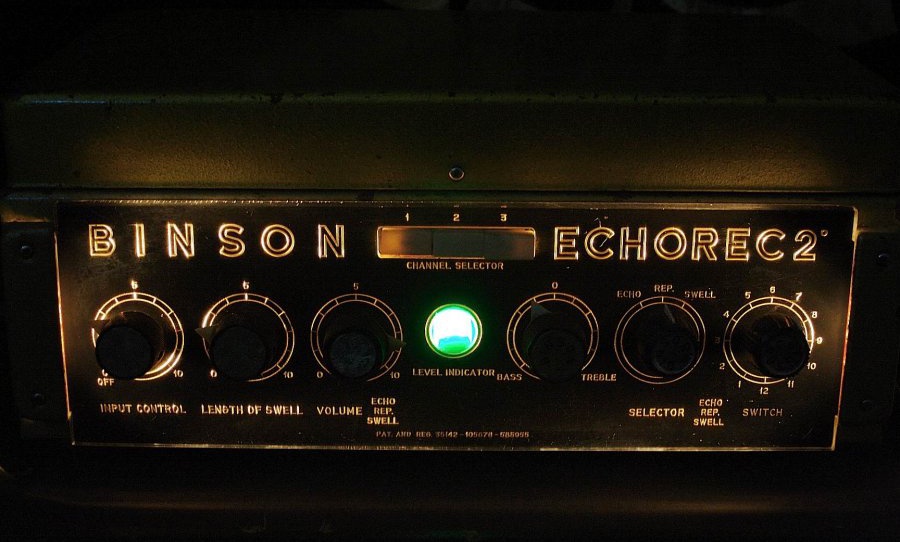The Binson Echorec. It’s an odd name. You mightn’t have heard of it, but you’ve definitely heard it. Where exactly? Oh, jeez I dunno, have you ever listened to Pink Floyd before? Or how about a band called Led Zeppelin? Assuming that’s a yes, let’s move on.
The Echorec’s gold-painted steel housing makes the unit look more espresso machine than delay effect. Maybe that’s expected from a Milanese mid-century design, but when it comes to echoes, there’s absolutely nothing in the world that sounds better… Except for maybe a very deep canyon, but who’s got that kind of studio space these days?
It might look like an espresso machine, but the Binson Echorec is responsible for the most legendary delay sounds this side of the Grand Canyon.
Repeating History
The Binson Echorec was introduced to the music world in 1955 and at the time, it stood miles ahead of any other audio effect. To be fair there wasn’t much in the way of effects at that time anyway, but the Echorec was specifically designed to be ahead of the tape delays and reverb plate contemporaries.
Binson founder Dr Bonfiglio Bini had a long history with audio entrepreneurship. He had been crafting tube radios since the end of the second world war and eventually branched into the guitar amplifier market, but in the 1950s he decided he wanted to do something truly innovative.
Along with his principal engineer Scarano Gaetano, Dr Bonfiglio Bini undertook an extensive research phase to find a delay generating medium that sounded better and was more durable than the plastic magnetic tape that was standard at the time. The duo’s groundbreaking design was like nothing seen before and would shortly take the audio world by storm.
The Binson Echorec’s main component was a steel-alloy disc-shaped drum, driven by a powerful AC motor via a rubber jockey wheel. Playback and record heads were arranged around the circumference of the machine, which picked up varying delay times.

The Echorec had huge advantages over its tape machine contemporaries as it boasted a wider frequency response and low ‘wow’ and ‘flutter’ levels, making for a sturdy delay sound. By most accounts, the AC motor was also much quieter than other machines of the day.
The machine was basically considered the Rolls Royce of delays at the time and like the car, it didn’t come cheap. In 1962 a VOX AC30 cost around £119.00, a new Stratocaster, £160.00. Binson’s cheapest baby model, by comparison, cost £140.00, it was a lot of money for a singular effect, even if it did sound incredible.
Imagine if Strymon tried to sell a new effect for $2000 today…
Form and Function
The Echorec was a relatively complex device by the standards of the day and its operation is heralded as a marvel of analog audio engineering. The unit’s steel-alloy drum spun over four playback heads that ran through six 6 12AX7 preamp tubes.
Each drum was crafted from three parts: a steel axle, the balanced wheel and an aluminium thread ring. Running around the outside of the ring was a length of 100 super-fine stainless-steel recording wires, each 0.1mm in diameter. That’s about the thickness of a hair. The job of winding these thin strands was extremely difficult. It’s been said that new workers at the factory would typically massacre many before getting the hang of the meticulous task.
The record and playback heads were positioned around the circumference of the drum. First up was the record head, followed by the playback heads, which gave four different rhythmic tap settings. It took 74ms for the first playback head to read the signal recorded from the drum, producing a 74ms delay. The second head was good for 148ms, 222ms for the third and 296ms for the fourth.

Dr Bini could have been happy with the world’s best sounding delay, but he pushed his design just that little bit further by carefully considering the ratios of spacing between each head. Each of the Echorec’s playback heads were related to each other, the first produced a sixteenth tap, the second an eighth, the third a dotted eighth and the fourth a quarter.
There was no control for delay time, as each distance was set, however different combinations of the four playback heads provided unique customisation as well as unique rhythmic repeat patterns.
The Echorec has three delay settings: Echo, for slapback sounds, Repeat, for a more standard sounding delay and Swell which mixed and blended the sound for a reverb-like effect. The Swell amount could be increased for more feedback and a Bass/Treble control changed the tone subtly from brighter to darker.
All in all the Echorec sounded like nothing else, it was a steady delay, but it also sounded more metallic and modulated than tape delays. The overall tone was beautifully haunting and ethereal. No surprises that it became a favourite for some of music’s most influential artists.
Famous Users
Although the Echorec was an expensive bit of kit, it’s incredible sound soon started to catch on in various avenues of music. The Rockabilly movement loved the slapback sound that could be produced with the Echo function, and for similar reasons, the surf movement adopted the unit as it made waves on both sides of the Atlantic.
One of the earliest big stars to find use in Italy’s finest repeating machine was none other than Hank Marvin of the Shadows. Marvin had established his sound using Meazzi Echomatic tape delay machines but upgraded to the Echorec in the early 1960s.
Legendary sound designer Delia Derbyshire, best known for composing the Doctor Who Theme was another big user of the Echorec while working at the BBC Radiophonic Workshop in the 60s and 70s.
The metallic echo and otherworldly ambience of the Echorec made it a go too as the psychedelic 60s rolled around, becoming a favourite for bands such as Hawkwind, who used the Swell function to create wild warbling soundscapes.
A young guitarist named Jimmy Page eventually got his hands on one and employed the unit on a famous song called When The Levee Breaks. On that note, the Echorec wasn’t just used on the guitars on Led Zeppelin IV.
It’s a bit of a legendary fact that John Bonham’s huge drum sound was created by recording from the bottom of a stairwell in Headley Grange. The huge sound was captured with two Beyerdynamic M160s on the first floor, which recorded Bonzo’s reverberation as it shot up the stairwell towards heaven.

Producer Andy Johns processed this already monumental sound with limiters, before running it through a Binson Echorec. The result was an epic reflecting thump that sound engineers still talk about to this day, and probably will for years to come.
Johns recalled the process later in an interview with Music Radar, “The limiters had time to breathe and that’s how Bonzo got that ‘Ga Gack’ sound because of the Binson. He wasn’t playing that. It was the Binson that made him sound like that.”
Despite Led Zeppelin’s handy work, few bands got their money’s worth like Pink Floyd. The effect was instrumental in the bands early sound, and the original frontman Syd Barrett used a Echorec 2 T7E to great extent. You can hear it at work creating eerie soundscapes on Interstellar Overdrive and Astronomy Domine.
When David Gilmour filled Barrett’s place in 1968 he continued with the same setup as Syd, taking the golden Binson in new creative directions. Perhaps the most coveted example of the Echorec’s magic is Gilmour’s solo on Time from 1973’s Dark Side of the Moon, if you haven’t heard it, it’s a good album you should probably check it out.
Gilmour often used a combination of echo and fuzz to string together long and emotive solos, but despite his infamous work, his bandmates also had their fair share of fun with the device. Keyboardist Richard Wright was known to run his organ thought the Echorec from time to time, using the swell function to create ethereal textures. Roger Waters employed the device rhythmically, using the pulse of the Echorec on the cleaner Repeat setting to form a looping bass line, a great example is 1972’s One of These Days.
One of the best sonic display of the Echorec can be heard and seen during Pink Floyd’s Live at Pompeii concert, where both Gilmour and Wright create huge atmospheres and strange sonic experiments as seen in the video below (look out for the shiny gold box).
Digital Emulations
The Binson Echorec was produced in small numbers in a small factory in Milan from 1955 to 1981, so needless to say, it’s a bit of a rarity. Echorecs that are still kicking are notoriously difficult to maintain, it’s for that reason that Gilmour himself gave up the big gold box for a digital delay towards the end of the 70s.
Luckily, we live in an age where computers are getting smarter by the day, and digital emulations of analogue effects are nearing seamless. There are many great digital recreations of the legendary effect, both in pedal form or software download. The beauty of digital emulations is that you don’t have to fork out the price of a used Honda Civic, nor do you have to maintain and oil the rotating drum.
If you’re a pedal user be sure to check out the Catalinbread Echorec, Strymon Volante, The Dawner Prince Boonar Multi-Head Drum Echo and the Gurus Amps Echosex 2. Each make has it’s own take on the classic sound with updated modern controls, such as delay time, which is always handy.
If software plugins are more you’re thing, have a good look at the Pulsar Echorec, Overloud Echoson, and Auditory Echoes T7E. Each of these are amazingly flexible and will probably be your new favourite delay on your DAW. Try using the effect on vocals, you won’t be disappointed.
Golden Legacy
The Binson Echorec has undoubtedly carved a spot in the history of audio effects, and although the unit was made famous at the hands of some of rock’s finest decades ago, the sound has been making a comeback. Amongst the newer fans of the sound is the Chemical Brothers, who a few years ago shared a photo of their studio setup that has not one, but two Echorecs present.
If the booming digital emulation market isn’t homage enough to the unit then I don’t know what is. Oh actually, pedal-makers T.Rex have actually stated that they are working on a new rendition of Dr Blini’s original design with moving parts and all (pictured above). The company hasn’t stated when it will be out but it looks like the next best thing to the real thing.
If you have a bit of money to spend than, there’s really nothing like the real thing. If you want to invest it’s probably best to check out a company such as SoundGas, who specialise in saving old Echorecs and refurbishing them to near-new condition. Be sure to opt for the drum oil and keep the Echorec legacy repeating for years to come.




